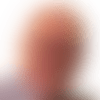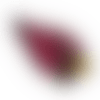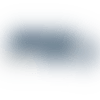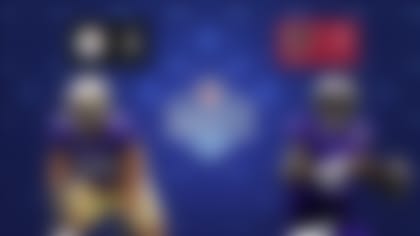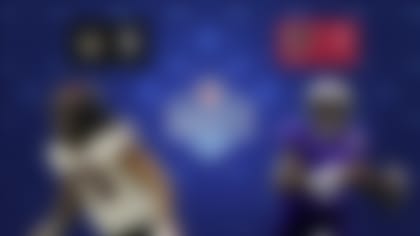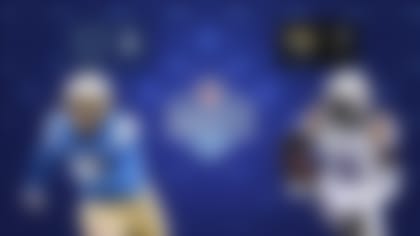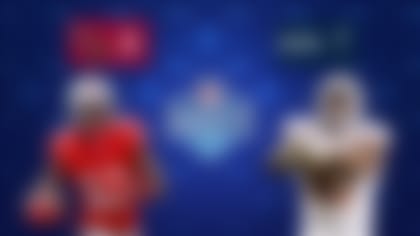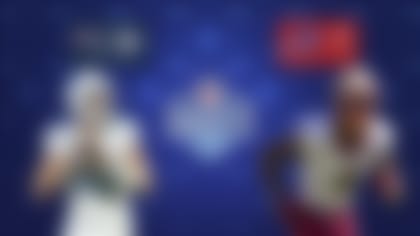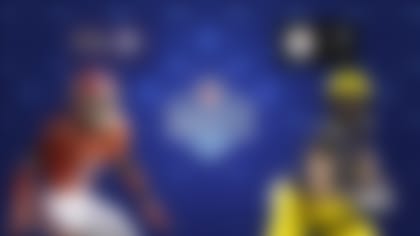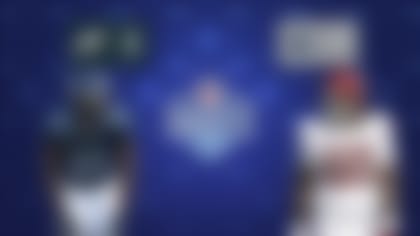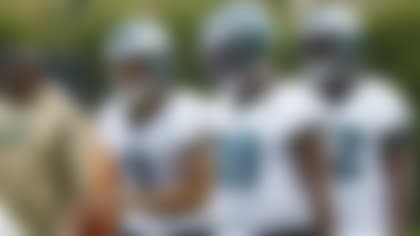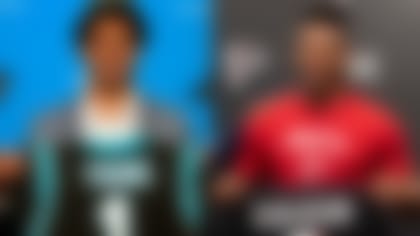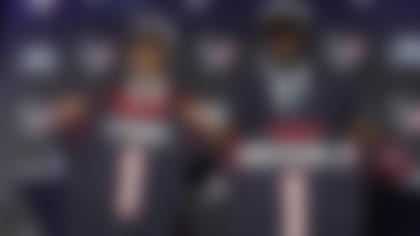NFL.com analysts Chad Reuter and Bucky Brooks are handing out grades for every team following the 2012 NFL Draft. Click the team name to see each team's entire class.
Coming off an 8-8 season with a strong finish (7-2), the Cardinals hope this new draft class can help them get off to a better start in 2012. They bolstered their offensive line with three picks of excellent value, found another weapon for the passing game, as well as a potential starting cornerback. They did not address the need for a pass rusher, though, so recent fourth-round picks O'Brien Schofield and Sam Acho better get after the quarterback if the defense is to hold up its end of the bargain.
Coming off an 8-8 season with a strong finish (7-2), the Cardinals hope this new draft class can help them get off to a better start in 2012. They bolstered their offensive line with three picks of excellent value, found another weapon for the passing game, as well as a potential starting cornerback. They did not address the need for a pass rusher, though, so recent fourth-round picks O'Brien Schofield and Sam Acho better get after the quarterback if the defense is to hold up its end of the bargain.
Best pick: Michael Floyd, WR, Notre Dame (Round 1, 13th overall pick).
Pairing Floyd with Larry Fitzgerald was a no-brainer. Though maybe not in Fitzgerald's class in terms of his hands, the two-time Irish MVP has the size and physicality to take advantage of defenses rolling to his Pro Bowl teammate's side.
Questionable pick: Kevin Kolb, QB, Houston/Philadelphia Eagles (Round 2, 51).
Yup, I'm cheating a bit here. The Cardinals made solid selections through the draft, so the biggest remaining question is whether the acquisition of Kolb from the Eagles in exchange for what turned out to be the 51st pick in last Friday's second round (and cornerback Dominique Rodgers-Cromartie) will work out as planned.
Sleeper pick: Senio Kelemete, OG/OT, Washington (round 5, 151).
The team got long and athletic tackle Bobby Massie in the fourth round to help rebuild the offensive line, but Kelemete's potential to swing between the tackle and guard spots is a less-discussed move that will pay dividends in 2012 and beyond.
One of the league's biggest surprise teams in 2011 (13-3, NFC Championship Game appearance) won't sneak up on anyone this year. Jim Harbaugh will have his guys ready to play, though, and used the draft to plug some holes on the offensive line and at linebacker, despite picking near the end of every round. There are questions as to whether A.J. Jenkins was worth a first-round pick. He flashes a Mike Wallace-type game, but some scouts thought he was a carbon copy of Brandon Lloyd (who did not produce much in his first three professional seasons in San Francisco).
Best pick: Joe Looney, OG, Wake Forest (Round 4, 117).
His injury at the Senior Bowl was unfortunate, as it prevented teams from seeing his strength and versatility as a guard and center -- and also kept him from participating at the NFL Scouting Combine. But his physical nature and athleticism will allow him to challenge for a starting spot with the Niners in the near future.
Questionable pick: LaMichael James, RB, Oregon (Round 2, 61).
As I've mentioned with several of these "questionable" picks, James' listing here is not really about his talent level; his elite speed and quickness should make a good change-of-pace back in the NFL. But with Kendall Hunter already in the fold and other similar backs available later in the draft, the 49ers could have taken a cornerback, defensive end or linebacker who met more immediate needs.
Sleeper pick: Cam Johnson, OLB, Virginia (Round 7, 237).
The Niners simply needed more bodies at outside linebacker, so finding a possible down-the-road starter in the seventh round was a major bonus. Johnson looks like a prototypical 3-4 rusher, but he only had four sacks in 2011 and scouts question his consistency. He'll be a steal as a grass-eater off the edge if able to reach his potential.
Once again the Seahawks made a surprise first-round selection, picking West Virginia defensive end Bruce Irvin with the 15th overall pick one year after securing workman-like offensive lineman James Carpenter at 25. They addressed a big need for a starting linebacker by selecting Bobby Wagner in the second round, found a reliable reserve quarterback in Wisconsin's Russell Wilson and added depth on defense with later picks accumulated in trades.
Best pick: Robert Turbin, RB, Utah State (Round 4, 106).
The second of two Aggies the Seahawks picked this year (along with Wagner), Turbin's value in the fourth round was too much to pass on, despite the team's signing of Marshawn Lynch to a four-year, $31 million contract in March. He can carry the mail a few times per game if Lynch is still hitting his stride, or be a reliable 20-carry back if Lynch is ever sidelined due to injury.
Questionable pick: Bruce Irvin, DE, West Virginia (Round 1, 15).
Irvin's ability as a pass rusher is well-documented, and the fact he had any success playing on a three-man front at 235 pounds is a tribute to his work ethic. He weighed 245 at the combine, but will need to prove himself either a capable every-down player in the 250-pound range or effective enough as a nickel rusher to warrant a top-15 selection (particularly when Melvin Ingram, Quinton Coples and Chandler Jones were still on the board). Staying out of trouble off the field will also help him win over doubters.
Sleeper pick: Jaye Howard, DT, Florida (Round 4, 114).
Howard flashed explosiveness as a penetrating three-technique and was moved outside at times due to his overall athleticism. If coaches can get him to play physical every snap, they'll have found a real bargain.
New general manager Les Snead had his work cut out for him, taking over a roster devoid of playmakers. The lack of talent resulted in a lucky break for the new administration; the Washington Redskins handed over a second-round pick this year and first-rounders in 2013 and 2014 to swap 2012 first-rounders with St. Louis so they could select quarterback Robert Griffin III. The Rams proceeded to trade down again on draft night (with the Cowboys, who took cornerback Morris Claiborne), gaining yet another second-round pick. But Snead took some risks with each of his top six picks, adding talented players with question marks about their off-field conduct and/or level of competition. Strong (but young) defensive tackle Michael Brockers was Snead's first draft pick with the team -- and could be the bellwether pick of the class, too.
Best pick: Janoris Jenkins, CB, North Alabama (Round 2, 39).
Jenkins' off-field concerns are the greatest of all the team's early picks -- but so is his talent. The man-cover skills he displayed at Florida before being dismissed for multiple marijuana-related offenses could give Snead a nice payoff for taking a chance in the top 40. If fellow corner Trumaine Johnson also reaches his potential, they'll form a tough duo outside.
Questionable pick: Brian Quick, WR, Appalachian State (Round 2, 33).
Jacksonville's trade-up in Round 1 cost the Rams a chance at top receiver prospect Justin Blackmon, so they grabbed a Quick solution with the first pick of the second round. He has an NFL frame (6-foot-3, 220), but his level of competition and ability to grasp NFL offenses were serious concerns for scouts. Even though it's unfair, Quick's career will always be compared to the bigger-named receivers picked after him: Stephen Hill, Alshon Jeffery and Rueben Randle.
Sleeper pick: Chris Givens, WR, Wake Forest (Round 4, 96).
If Quick doesn't work out, the team might have found a good insurance policy in Givens. He doesn't tower over defenders like Quick, but his 4.4 speed and solid hands make him a promising vertical threat. He must prove to his coaches that he's ready to do what is necessary to succeed, but if he does -- NFL defenses beware.
Follow Chad Reuter on Twitter @ChadReuter
